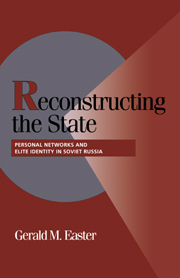Book contents
- Frontmatter
- Contents
- Preface
- 1 Introduction: Explaining State-Building Outcomes and the Soviet Russian Case
- Part I Structure and Identity in the Postrevolutionary State Elite
- Part II Informal Sources of Power in the Postrevolutionary State
- Part III Intrastate Conflict and the Constraints of Power Redefined
- 6 Center and Regions in Conflict I: Collectivization and the Crisis of Regional Leadership
- 7 Center and Regions in Conflict II: The Fall of the Provincial Komitetchiki
- 8 Conclusion: State Building and the Soviet Russian Case Reconsidered
- Notes
- Bibliography
- Index
- Titles in the series
6 - Center and Regions in Conflict I: Collectivization and the Crisis of Regional Leadership
Published online by Cambridge University Press: 13 October 2009
- Frontmatter
- Contents
- Preface
- 1 Introduction: Explaining State-Building Outcomes and the Soviet Russian Case
- Part I Structure and Identity in the Postrevolutionary State Elite
- Part II Informal Sources of Power in the Postrevolutionary State
- Part III Intrastate Conflict and the Constraints of Power Redefined
- 6 Center and Regions in Conflict I: Collectivization and the Crisis of Regional Leadership
- 7 Center and Regions in Conflict II: The Fall of the Provincial Komitetchiki
- 8 Conclusion: State Building and the Soviet Russian Case Reconsidered
- Notes
- Bibliography
- Index
- Titles in the series
Summary
The conflict between center and regions that unfolded in the 1930s represented a clash of interests between two distinct power centers within the state. On one side, a group of central actors was intent on concentrating the despotic powers of the state in the center, in general, and in the person of Stalin, in particular. They sought to transform the infrastructural powers of the state along bureaucratic rather than patrimonial lines. Central actors defined their interests in a monopolistic claim on national security policy and national economic development. On the other side, a group of regional leaders sought to share in the despotic powers of the state. They sought to eliminate arbitrariness in the state's rule-making process. They wanted to maintain the patrimonial system of infrastructural power. The interests of this group were shaped by more narrowly defined corporate interests and a distinct status image. The center–regional conflict, in effect, was a battle over the institutionalization of power and status in the new state. The center preferred a “bureaucratic absolutist” regime type for the state, while the Provincial Komitetchiki preferred a “protocorporatist” regime type.
No issue did more to expose the strains in the center–regional relationship in the first half of the 1930s than the collectivization of agriculture. By the end of the 1920s, a consensus formed within the political elite that agricultural collectivization was a necessary component of any plan for national economic development.
- Type
- Chapter
- Information
- Reconstructing the StatePersonal Networks and Elite Identity in Soviet Russia, pp. 109 - 132Publisher: Cambridge University PressPrint publication year: 2000



